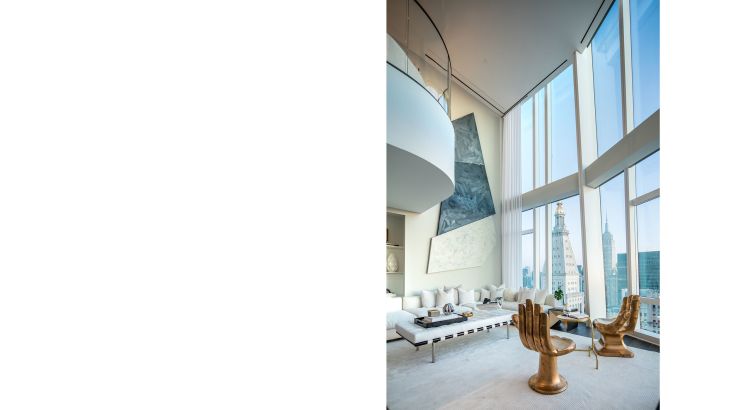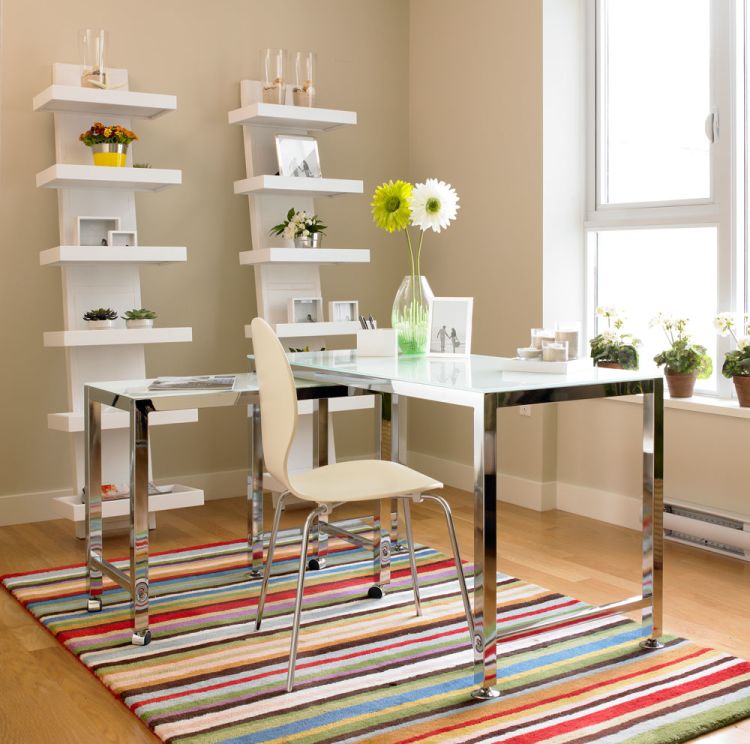On-Trend Tips for Your Living Room, Bedroom and Office
Top designers spill their secrets

One of the challenges homeowners face when it comes to revamping their interiors is selecting design schemes that are at once of the moment and timeless, to stay on-trend without adding features to their home that risk quickly becoming dated.
To that end, many homeowners are splitting the difference between the traditional and the contemporary by opting for transitional interior designs.
“There was a huge movement in recent years from the heavy, dated Mediterranean aesthetic to a cleaner, more transitional look, highlighted by crisp white or pale grey walls, quartz countertops, and fixtures with clean lines,” said Meridith Baer, of the Los Angeles-based Meridith Baer Home. “In modern homes the trend has shifted from a sleek, sterile look to one that features more warmth by incorporating warm woods, quartz, and even a few brass accents.”
Nicole Langelier, creative director of Melbourne’s Design + Diplomacy, agreed that her clients, too, are moving away from heavy, dark, antique looks, and toward transitional designs with contemporary furnishings.
“I try to focus on timeless designs and am wary of super-trendy things,” she said. “The rosy gold shades and velvet textures were really huge trends that came on fast, but that was out before it even hit the shelves.”
So what are the latest interior design trends for living rooms, bedrooms, and home offices that should also prove to have staying power? Read on for tips.
Living Room

One trend that has emerged over the past decade, and that designers agree is here to stay, is the open-floor plan. Homeowners continue to reject discrete spaces in favor of taking down walls to create expansive, open living and dining areas.
“Even when clients have the square footage, they still aren’t building separate formal living and dining spaces,” said Holly Hollenbeck, principal designer with the San Francisco-based HSH Interiors.
They’re also seeking both comfort and flexibility; homeowners want living rooms that are multipurpose.
“They want their living spaces to feel cozy but also a little bit glam,” Ms. Hollenbeck said. “They should function equally for two people at the end of the day to sit on the couch and binge on Netflix, and also to host a dinner party for 10.”
Furnishings that facilitate this flexibility, she added, might include sectional sofas, as well as ottomans and oversized floor pillows that can be moved around to create informal seating, and large coffee tables for casual dining.
Color-wise, today’s homeowners want “nothing too out of the box,” Ms. Langelier said. “They’re seeking a neutral palette, with charcoal, taupe, tan, or brown, something you can layer with soft furnishings like throw pillows to bring in current trends that way.”
Ms. Baer agreed that a neutral palette provides the elegant, understated look that is on trend today.
“Oversized, overstuffed, and patterned furniture has become a thing of the past. Instead, current trends feature clean, simplistic lines and neutral colors,” she said.
That said, the latest design trends aren’t entirely about quiet, muted tones. Homeowners are adding dramatic flair to their spaces with dark accents.
“Black on walls and kitchen countertops, and black-stained cabinetry and architectural features, like windows, columns, pipes, will add drama and be a bold statement in any room,” said Vian Abreu, senior interior designer for Interior Marketing Group in New York. “Rich textures like black marble and quartzite, as well as ebony wood stains and lacquered finished millwork, will make a room feel luxurious and elevated.”
And these dark surfaces work best when the rest of the furniture, rugs or carpeting, and artwork in the room are in light or neutral shades, creating a welcome sense of contrast, she added.
Photography by Interior Marketing Group

Bedroom

Coziness and comfort come first for her clients when designing bedrooms, Ms. Hollenbeck said.
“They want lush fabrics, and high thread count sheets are still important,” she said.
Many homeowners are also seeking personalization when it comes to linens and other materials, creating for both themselves and their guests the feel of a luxe getaway.
“Some clients want a logo or brand for their house embroidered on pillowcases or bathrobes for guests,” Ms. Hollenbeck said. “It’s a one-of-a-kind feature, and it’s also helpful for the homeowner to know which sheets go on which bed.”
Ms. Langelier explained her approach to design proceeds from the “little black dress” theory “If you have a great design foundation and great bones, you can continue to update the style with current trends, but without doing anything really major,” she said.
In the bedroom, this could mean going neutral with the bed and headboard, and then making it more striking by dressing it with different, colorful linen combinations.
Another priority for many homeowners is to add design features that hide their screens when they’re not in use.
“Most clients want a TV in their bedrooms, but they don’t necessarily want to see it,” Ms. Hollenbeck said.
Solutions include screens that drop down from the ceiling with the push of a button, or that are hidden in cabinets. For one client, Ms. Hollenbeck said, her team built a cabinet that floated in the middle of the bedroom, from which the TV came up and rotated 180 degrees so that it could be watched from the bed or from seating arrangements on the other side of the space.
Another trend with an air of timelessness is the use of metal accents in lighting fixtures and hardware to spice up otherwise understated spaces.
“Brass remains as popular as ever with savvy, on-trend designers,” Ms. Langelier said. “Once reserved for more traditional design, brass lighting and hardware has become prevalent in even the most modern and contemporary homes, adding a touch of warmth and refinement. It's no longer taboo to mix metals in a home as well, and current designs often feature brass paired with chrome, brushed nickel, or gunmetal.”
Ms. Abreu agreed that layering metal finishes like brass, as well as rose gold, nickel, and chrome, is an increasingly popular approach to enlivening homes: “From kitchens and bathrooms to living spaces and bedrooms, combining metals will add depth and interest to any space,” she said.
Photography by Interior Marketing Group

Home Office

For home offices, the trick is to create a workspace that is appealing and welcoming, and this typically involves concealing their clunkier, more functional aspects.
“With laser printers and other office machinery, we try to hide them behind cabinetry and wire up drawers so they don’t have to sit on the desk,” Ms. Hollenbeck said. “Anything to keep it feeling like a beautiful, organized space where you want to go and work, but when the work materials are put away it’s lovely to look at.”
A challenge in designing home offices is managing the tangles of wires that come with the ever-increasing amount of tech homeowners need to stay connected. Desks with easy power access are in demand, as are hotel-inspired features like pop-up electrical sockets or flash drive chargers.
Managing light and sound is also critical to creating a room in which homeowners can stay focused on their work.
“Most clients now have so many large walls of glass, and it can be hard to make that cozy, since it bounces sound,” Ms. Hollenbeck said.
To manage this, there are trends toward heavy drapery to augment automated shading systems, helping to block harsh sunlight and noise.
“We double up on automated shades with floor-to-ceiling, luxe drapers, like linen or cashmere for a layer of softness,” Ms. Hollenbeck said.


